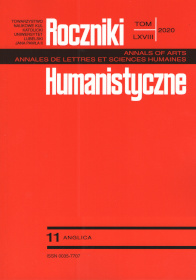Caribbean Landscape and the Construction of Creole Consciousness in Jean Rhys’s Wide Sargasso Sea
Abstract
This article aims to analyse the relationship between the depiction of place and the construction of Creole identity in Jean Rhys’s 1966 novel Wide Sargasso Sea. My main contention is that the novel’s Dominican protagonist undergoes an evolution in her Creole consciousness, and that this evolution is manifested in her varying degrees of (dis)connection with Dominica’s nature. Accordingly, this character-narrator reflects the link between place and identity by recalling certain events belonging to her past and, most importantly, her interaction with Caribbean landscape at different stages of her life in her native place. By examining the relationship between identity formation and Caribbean landscape, this article attempts to widen the scope of literature on memory retrieval in Jean Rhys’s fiction while casting new light on the paramount role of the Caribbean landscape in Wide Sargasso Sea.
References
Antinucci, Raffaella. “Jean Rhys and the Duplicity of Landscape.” Scritture femminili: da Mary Wollstonecraft a Virginia Woolf, edited by Andrea Mariani, Francesco Marroni, and Massimo Verzella, Aracne, 2009, pp. 273–83.
Balaev, Michelle. “Trends in Literary Trauma Theory.” Mosaic, vol. 41, no. 2, 2008, pp. 149–65.
Caparoso-Konzett, Delia. Ethnic Modernisms: Anzia Yezierska, Zora Neale Hurston, Jean Rhys, and the Aesthetics of Dislocation. Palgrave Macmillan, 2002.
Drake, Sandra. “Race and Caribbean Culture as Thematics of Liberation in Jean Rhys’s Wide Sargasso Sea.” Wide Sargasso Sea, by Jean Rhys, edited by Judith L. Raiskin, a Norton critical edition, Norton, 1999, pp. 193–206.
Emery, Mary Lou. Jean Rhys at “World’s End”: Novels of Colonial and Sexual Exile. U of Texas P, 1990.
Erll, Astrid. “Locating Family in Cultural Memory Studies.” Journal of Comparative Family Studies, vol. 42, no. 3, 2011, pp. 303–18.
Eyvazi, Mojgan, Shirin Pourebrahim, and Nasim Sahebazmani. “Evaluation of Intertextuality and Irony in Jean Rhys’s Wide Sargasso Sea: A Postmodern Outlook.” International Journal on Studies in English Language and Literature (IJSELL), vol. 2, no. 9, 2014, pp. 153–64.
Gildersleeve, Jessica. “Jean Rhys’s Tropographies: Unmappable Identity and the Tropical Landscape in Wide Sargasso Sea and Selected Short Fiction.” Etropia, vol. 10, 2011, pp. 32–38.
Gregg, Veronica M. Jean Rhys’s Historical Imagination: Reading and Writing the Creole. U of North Carolina P, 1995.
Lai-Ming Ho, Tammy. Neo-Victorian Cannibalism: A Theory of Contemporary Adaptations. Palgrave Macmillan, 2019.
Loe, Thomas. “Landscape and Character in Jane Eyre and Wide Sargasso Sea.” A Breath of Fresh Eyre: Intertextual and Intermedial Reworkings of Jane Eyre, edited by Margarete Rubik and Elke Mettinger-Schartmann, Editions Rodopi, 2007, pp. 49–61.
Malissa, Inna bte Che Jamal, Hardev Kaur, and Manimangai Mani. “A Study of Displacement in Jean Rhys’ Novel Wide Sargasso Sea.” Advances in Language and Literary Studies, vol. 5, no. 5, 2014, pp. 111–18.
Mardorossian, Carine M. “Caribbean Formations in the Rhysian Corpus.” Jean Rhys: Twenty- First-Century Approaches, edited by Erica L. Johnson and Patricia Moran, Edinburgh UP, 2015, pp. 107–22.
Nora, Pierre. “General Introduction: Between Memory and History.” Realms of Memory: Rethinking the French Past, 3 vols., Columbia UP, 1996, pp. 1–20.
O’Connor, Teresa F. Jean Rhys: The West Indian Novels. New York UP, 1986.
Pyrhönen, Heta. Bluebeard Gothic: Jane Eyre and Its Progeny. U of Toronto P, 2010.
Rhys, Jean. Wide Sargasso Sea. 1966. Penguin Books, 2000.
Savory, Elaine. The Cambridge Introduction to Jean Rhys. Cambridge UP, 2009.
Söderberg, Emelie. “‘I Often Wonder Who I Am’: Identity, Landscape and Sexuality in Wide Sargasso Sea.” 15 Jan. 2010. Linnaeus U, student paper.
Weaver, Melanie B. Meeting the Madwomen: Mental Illness in Women in Rhys’s Wide Sargasso Sea, Hijuelos’s Our House in the Last World, and Garcia’s Dreaming in Cuban. 2012. East Carolina U, Master’s thesis.
Copyright (c) 2020 Roczniki Humanistyczne

This work is licensed under a Creative Commons Attribution-NonCommercial-NoDerivatives 4.0 International License.





